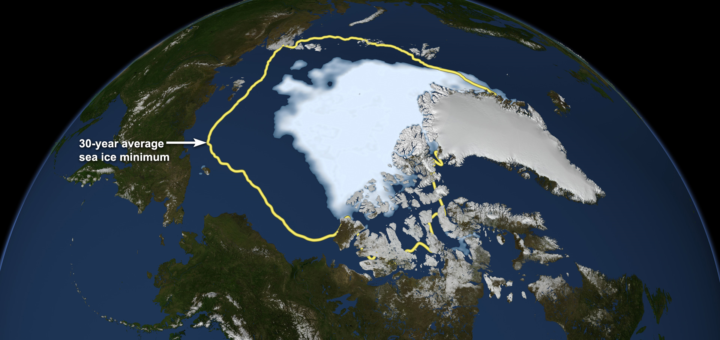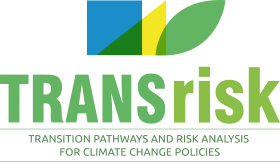Arctic sea ice decline in recent decades is one of the most visible indicators of global warming. The sea-ice albedo feedback is an essential impact of sea ice melt, which amplifies Arctic temperature change. In this study, an optimal path for fossil fuel and industrial CO2 emission reduction is sought. Devoting more resources to mitigation implies a decrease in consumption and investment, implying a loss in net welfare.
The rapid decline of Arctic sea ice extent in recent decades is one of the most visible indicators of global climate change. An important impact of sea ice melt is the sea-ice albedo feedback, which amplifies Arctic temperature change.
The sea-ice albedo feedback (SIAF) refers to the process where when ice (with high albedo/reflectivity) melts, exposing open water (with low albedo) to solar radiation. This means more energy from the sun is absorbed, generating a self-reinforcing warming mechanism. Although SIAF is not the only feedback mechanism associated with sea ice loss it is thought to have a central role in recent Arctic temperature amplification.
Scenarios and Model
The TRANSrisk report on the Economic Implications of Climate Change studies the implications of mitigating climate change to below 2°C in the presence of rapid changes in artic sea-ice albedo. Specifically, it studies the implications of the month of September becoming sea ice free by 2050.
Although plausible given the current trends, climate models consider this scenario to be a rapid transition. Based on current debates about the potential climate recovery three different pathways for sea ice beyond 2050 are considered: recovery, stabilisation or continued sea ice loss (or tipping-point).
The report uses the Dynamic Integrated Climate-Economy model, an integrated assessment model (IAM), for analysis of the economic implications of different climate pathways. The model weights the cost and benefits of investing in emission reduction and reducing present consumption, but keeping future global temperature increases under a set limit.
In this study, an optimal path for fossil fuel and industrial CO2 emission reduction is sought that maximises the net present value of cumulative economic welfare from 2010 to 2100, subject to a constraint on radiative forcing (warming impact). In this approach economic welfare corresponds to net welfare, i.e. the damage from climate change and the mitigation costs have already been deducted.
Results
Figure 1 depicts the resulting CO2 emission pathways to reach the 2.6 Wm-2 climate change control target. The additional warming associated with one month free of ice by 2050 is included under the three different sea ice recovery scenarios. Compared to the reference scenario emissions need to peak around 10 years earlier in the case of a stabilisation transition (RCP2.6_SIAF_Stabilisation) and 5 years in the case of a recovery transition (RCP2.6_SIAF_Recovery). In the case of continued sea ice loss (RCP2.6_SIAF_No-Recovery) emissions should have already peaked.
Notice that the optimal path of emissions for all scenarios (also in the RCP2.6 scenario) suggests that emissions in the period 2010-2015 should be lower than current emissions if the target is to be achieved at the least cost.
Figure 1: Implication of SIAF for fossil fuel and industrial CO2 emissions (GtCO2)
These pathways can be translated into the carbon price (or carbon tax) needed to achieve the desired transition. Under all of the sea ice scenarios, this must be higher than in the reference scenario, both now and in the future (Figure 2). Notice here again that the global price of carbon (or its equivalent in terms of regulation) for all scenarios should be much higher than today’s price if the target is to be achieved at the least cost.
The stringent mitigation policy and the higher carbon price implies higher costs for society. The presence of sea-ice albedo feedback would increase the mitigation cost from US$8.1 trillion in the reference scenario, to US$9.6 trillion (RCP2.6_SIAF_Recovery), US$10.6 trillion (RCP2.6_SIAF_Stabilisation) and US$13.1 trillion (RCP2.6_SIAF_No-Recovery), equivalent to cost increases of 19%, 30% and 64% (Figure 3).
The absolute mitigation costs obtained with the DICE model are in the low range of the literature. One of the main reasons is the inclusion of a ‘backstop’ technology, which puts an upper limit on the cost of CO2 mitigation (as Figure 2 shows) and also the discount rate which are set to match the observed market values (around 4%).
Figure 2. Implications of SIAF for carbon prices ($/tCO2)
Figure 3. Implications of SIAF for mitigation costs (Trillion 2005$)
Finally, devoting more resources to mitigation implies a reduction of consumption and investment, implying a loss in net welfare. Results show that the net present value of total welfare from 2010 to 2100 is reduced due to sea-ice albedo feedback in our scenarios by US$8.3 trillion in RCP2.6_SIAF_Recovery (-4% with respect to RCP2.6), by US$12.5 trillion in RCP2.6_SIAF_Stabilisation (-6%) and by US$25.1 trillion (-25%).
Sensitivity analysis for timing of sea ice free conditions
The above scenarios are stylised scenarios with the aim of exploring the implications of a hypothetical transition towards a month free of ice in September 2050. However, there is much uncertainty in relation to this timing, and thus a sensitivity analysis on the date for a full month free of ice between 2040 and 2060 is performed.
The results show that mitigation needs to be more stringent the earlier the date of the first ice-free month. Fossil fuel and industrial CO2 emissions need to peak at 28.4 GtCO2 in the least stringent scenario and 19.7 GtCO2 in the most stringent scenario, a reduction of 6.7 and 35.1% compared to RCP2.6. The carbon budget needs to be reduced from 1,386 GtCO2 to 768.1 GtCO2, a reduction of 11.9-51.2% compared to the RCP2.6.

This article is an output of the EU-funded TRANSrisk project. It is derived from work undertaken for Deliverable “D4.1: Economic implications of climate change” of the TRANSrisk project. This deliverable, and other TRANSrisk outputs can be downloaded from the project website (http://transrisk-project.eu/virtual-library/transrisk-results). The study was published in in Earth’s Future, a journal of the American Geophysical Union: http://dx.doi.org/10.1002/2016EF000429
Featured image credit: NASA/Goddard Scientific Visualization Studio
TRANSrisk
Project details
- Project title: “Transitions Pathways and Risk Analysis for Climate Change Mitigation and Adaption Strategies” (TRANSrisk)
- Funding scheme: European Union Horizon 2020 Programme (EU H2020, grant agreement no. 642260)
- Duration: 3 years (1 September 2015 – 31 August 2018)
- Project coordinator: Science Policy Research Unit, University of Sussex, United Kingdom
- Project website: www.transrisk-project.eu



